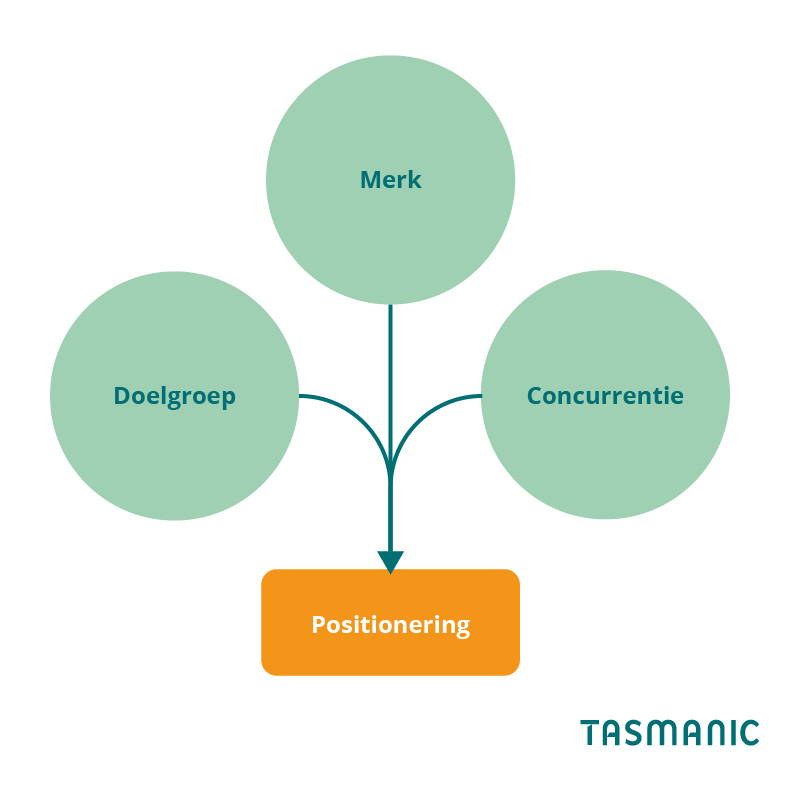
Introduction
Of course, as a business owner, you want your brand to have a permanent place in the minds and hearts of your target audience. To achieve that goal, it is important to develop a strong brand positioning. This makes it clear what your brand stands for, why the target audience chooses it and what makes it distinctive from competing brands. Determining a brand positioning is a complex job. The MDC model helps you give direction to this.

What is brand positioning?
Brand positioning is why a target audience chooses a particular brand. For example, why does someone buy an iPhone instead of a Samsung Galaxy? Customers have a clear picture of a brand and its values and make a choice based on that. Ee strong brand positioning ensures that the brand is unique and distinctive from competitors. Developing a brand positioning is a complex and creative process. It is therefore advisable to work with a model, which will help you determine the right brand positioning and brand strategy for your brand.
Meaning MDC model: what is it?
MDC stands for Brand, Target Group and Competitors. The MDC model was developed by Rik Riezebos and Jaap van der Grinten. It is a tool that helps you position your brand. The components Brand, Target Group and Competitors are the common threads in it. If you work through this model, you first name the identity of your brand. Then you choose which elements of that identity you want to emphasize. These are topics that are important to the target group and that clearly distinguish themselves from competing brands.
Brand
The M in the MDC model stands for Brand. The identity of your brand is the identity of your organization. You answer the following questions in this phase:
- What are the company's vision and mission? Where does the organization want to be in five years and what are its ambitions?
- What is the company history? What did the founders consider important, what were defining milestones?
- What is the business orientation; where is the focus? Is it the product, the process or the market? What does the company value most?
- What are the strengths (core competencies) of the company or product?
- What are the organization's core values and what customer values are important?
- What is the corporate culture, how do employees interact with each other?
Bedenk je een merkpositionering voor een product, dan is het belangrijk om ook de identiteit van het product te bepalen. Lees ook hier meer over merknamen bedenken of een merknaam op maat.
Target
The D stands for Target Group. It is important to determine which parts of your identity are relevant to your target audience. Therefore, make sure you have a clear picture of your target audience. Who are your customers, what values do they consider important, what problems do they have that your brand can solve? Choose the aspects of your identity that directly appeal to the target audience. A company like Apple has done this cleverly: the values of innovation and design make Apple products distinctive.
Competitors
The C stands for Competitors. During this step in the model, you examine how your brand compares to competing brands. In what areas is your brand the same as the competition and in what areas does it differ? It is also important to determine which product category your brand falls into, as customers often begin their customer journey by searching for a particular product. Your brand should clearly be seen as part of the desired product category.
Elaboration of MDC model into brand positioning statement
Once the MDC model has been completed and all questions have been answered, it is time to summarize the brand positioning. You do this in a brand positioning statement, a summary of a few sentences in which the three elements of the MDC model have their place. This formula for the positioning statement is often used:
For [target audience], the [brand] is the only [category] that offers [distinction & relevance] through [evidence/support points].
Example brand positioning statement
A good example is Walt Disney World's brand positioning statement:
For young people and those who are young at heart, Walt Disney World is the theme park that best offers an immersive and magical experience. This is because Walt Disney World, and only Walt Disney World, connects you to the characters and worlds you most desire.
Alternatives to the MDC model
The MDC model is not the only model for determining brand positioning, although it is one of the most effective. There are several alternatives available and it depends on your personal preference which model works best.
Alternative 1: McKinsey's Brand Driver Model
With this model, you bring into focus four components that will help you discover which elements determine your brand positioning:
1.Drivers: important attributes for the target group that are highly distinctive from the competition.
2.Antes: attributes that are important to the target audience, but are also claimed by the competition.
3.Fool's Gold: attributes that are distinctive from the competition, but do not drive brand loyalty.
4.Neutrals: attributes that are not relevant to the target audience.
The downside of this model is that the components are not always well estimated. For example, some brands have become big with properties first dubbed Fool's Gold.
Alternative 2: Simon Sinek's Golden Circle model
Simon Sinek 's Golden Circle model is familiar to most companies by now. This thought model originated from Sinek's research on successful companies. He saw that the most successful companies work with an "inside-out" approach. Their way of working focuses not on the offer ("what"), but on the "why": why does the company do what it does? Sinek believes that people do not buy from a company because of what it offers, but because of why it offers it. The Golden Circle model consists of three circles, with 'why' in the middle circle, 'how' in the second circle and 'what' in the third circle. This depicts the "inside-out" approach.
Alternative 3: the Brand Key model
The MDC model is an inside out model. Another approach is outside in, and for this the Brand Key model is a practical positioning tool. In it you follow 9 steps from which the positioning of your brand follows.
Ben jij tot een hele mooie bedrijfsnaam gekomen. En ben je nieuwsgierig naar jouw mogelijk volgende stappen. Lees dan zeker ook ‘Ondernemingsplan voorbeelden‘ en ‘merkidentiteit‘.
Are the results from your online marketing disappointing?
Request our no-obligation performance scan and we'll tell you where you're going wrong.

















 Team
Team FAQ
FAQ Vacancies
Vacancies Contac
Contac AWR
AWR Ahrefs
Ahrefs Channable
Channable ContentKing
ContentKing Leadinfo
Leadinfo Optmyzr
Optmyzr Qooqie
Qooqie Hubspo
Hubspo Semrush
Semrush




